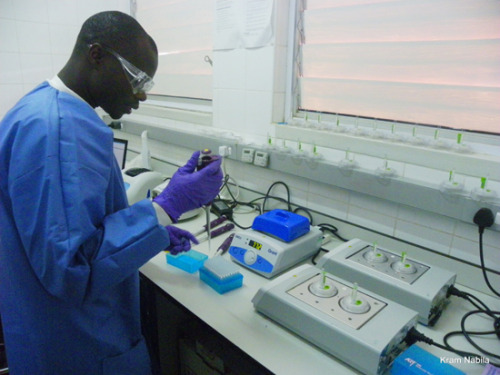Photo: An MSF staff member uses a SAMBA tool for rapid viral load monitoring. Malawi 2011 © Nabila Kram
MSF Research Points to Ways to Expand Viral Load Testing for HIV in Developing Countries
“Viral load monitoring—a test that measures the amount of virus in a person’s blood and thus the effectiveness of antiretroviral treatment—is critical in allowing treatment failure to be detected earlier, and ensuring that people receive the support they need to adhere to treatment,” said Dr. Jennifer Cohn, medical coordinator for MSF’s Access Campaign. “It’s a standard part of HIV disease management in developed countries but due to high costs and the lack of suitable technology, this type of virological monitoring is almost non-existent in developing countries. We need to challenge this state of affairs by ensuring there is financial and political support for roll-out of viral load in remote settings as a routine part of decentralized care.”
The two main barriers to roll-out of viral load concern the cost of testing and the difficulties of sample collection and transport. In two studies to be presented at CROI from its projects in Thyolo, Malawi, MSF will show how viral load monitoring can be adapted for resource-limited settings by using novel technologies and strategies to address these barriers.
The first study looked at simplification. Instead of conducting a blood draw, which requires a nurse, MSF was able to acquire blood samples by performing a simple finger-prick in order to prepare dried blood spots, which were then transported to a laboratory with viral load testing capabilities. Because dried blood spots (DBS) are easy to prepare, extremely stable at room temperature, and can even be sent in the mail, the finger-prick method of collecting samples in conjunction with the practicality of using DBS helps to overcome the challenges of health worker shortages and lack of sophisticated sample transportation networks for blood-based samples. This makes access to viral load testing easier for patients in rural areas, who no longer need to travel long distances to reach facilities with testing capacity.
A second viral load study to be presented at CROI looked at overcoming cost barriers preventing routine viral load implementation. MSF evaluated the accuracy and cost-saving of pooling samples of dried blood spots compared to individual viral load testing in a rural district laboratory in Thyolo, Malawi.
62 notes
 killevippen reblogged this from doctorswithoutborders
killevippen reblogged this from doctorswithoutborders  freedomforeverybody118 liked this
freedomforeverybody118 liked this wanderinghymns8 reblogged this from doctorswithoutborders
yellowkitchendreams-blog liked this
www-outerspacepi reblogged this from doctorswithoutborders
www-outerspacepi liked this
diegomolano-blog liked this
ppyzscottishadventures reblogged this from doctorswithoutborders
adelinens liked this
msnels101 liked this
morr74y liked this
morr74y reblogged this from doctorswithoutborders
abdulbasithfithroni reblogged this from doctorswithoutborders
compati liked this
purpuratus reblogged this from doctorswithoutborders
bellavira liked this
bellavira reblogged this from allofthestuffandthings
 the-strongest-stars reblogged this from doctorswithoutborders
the-strongest-stars reblogged this from doctorswithoutborders allofthestuffandthings reblogged this from doctorswithoutborders
quadradeesporte reblogged this from doctorswithoutborders
chocolate-soldier liked this
 ucsdhealthsciences liked this
ucsdhealthsciences liked this omnomnom74 liked this
 beledibabe liked this
beledibabe liked this shooting-stars-andsatellites liked this
willowendesign liked this
nasuskrap reblogged this from doctorswithoutborders
nasuskrap liked this
legendaryexcoworkers liked this
cloudstarwolf liked this
jennafox liked this
doctorswithoutborders posted this
- Show more notes

